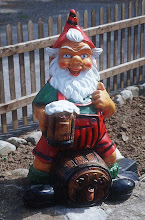
One of the things I least liked about homebrewing was bottling beer. It was time consuming. It was messy. But the part that bugged me the most was the sediment that collected at the bottom of the bottle. The sediment is yeast. Before beer is bottled, it is flat. Bottled homebrew is carbonated in the bottle. This is called bottle conditioning. Unless it is filtered (which is rare in homebrewing), beer contains yeast in suspension. During the beer making process, most of the yeast settles out of the beer as it ages and clears. But some of the yeast stays in solution. It is inactive because during the brewing process it has eaten up the available sugars. When beer is bottled a sugar solution is added to the beer. This gives the yeast something to eat and they reproduce, produce alcohol and CO2. This CO2 is what gives the beer its fizz. After the yeast has eaten this available sugar, it goes dormant again. Some of the yeast falls out of solution and produces the nasty looking sediment at the bottom of the bottle.
Beer sediment is harmless. In fact it is really good for you. It contains vitamins and nutrients. I had a friend that made a big production of swirling the sediment at the bottom of his homebrews, swigging it and telling anyone who was within earshot how good it was for them. After all, many expensive craft beers are bottle conditioned and have a layer of sediment at the bottom.
All the above information is useless however when you proudly give a friend a bottle of your precious homebrew which you think is the nectar of the gods, only to have them tell you that you must have done something wrong because there is stuff floating at the bottom, it must be spoiled, and they've thrown it out. When you tell them that the sediment should be there, they look at you funny and say something to the effect that their Bud Light bottles never have stuff floating in them.
When I first gave homebrewing a try in the 90's, everyone that I knew that homebrewed bottled their beer. At least in my circles, and local homebrew shop, kegging was not done and the parts were not available. Boy have things changed. When I decided to take homebrewing back up, I started looking on YouTube to see what others were doing. Boy was I surprised at the wealth of information and instruction available! As I delved more into what was being done, it soon became clear that kegging homebrew was not only now a viable option, but really popular. I guess the cost had come down considerably and it was now well within the economic reach of the homebrewer.
A homebrew kegging setup uses Cornelius (or Corny) kegs which are 5 gallon kegs designed to hold soft drink syrup. Most homebrew shops carry reconditioned corny kegs that are retired soda kegs. They are pretty cheap and at 5 gallons are a manageable size for a homebrewer. Add a canister of CO2 and some hoses and you are in business. The whole system can be put in a fridge and you can have draft beer any time you like. If you want to get fancy, you can put the keg in a commercial kegerator, or you can build your own kegerator out of an old fridge, or you can even build one out of a small bar fridge.
Instead of using yeast to produce the beer fizz, kegged beer is carbonated using a CO2 tank. Therefore kegged beer has no sediment. I even found out that there are ways to bottle kegged beer so that you can share your beer with your friends and it'll look just like their Bud Light. No sediment, no tossed beers. I decided that kegging was the way to go.

No comments:
Post a Comment